#aot hanakotoba
Explore tagged Tumblr posts
Text
SNK FINAL ED: ITTERASSHAI
HANAKOTOBA ANALYSIS
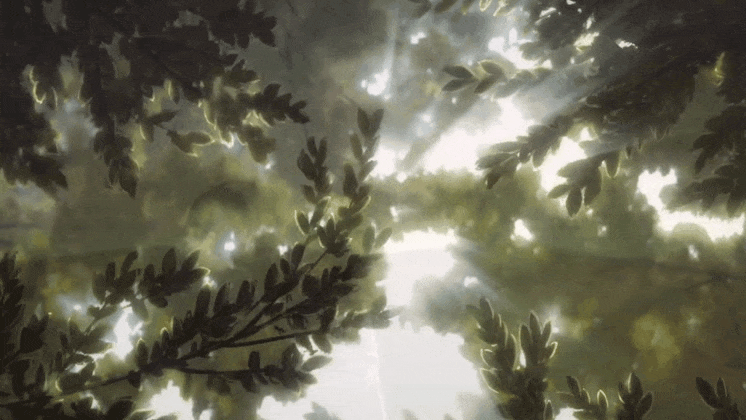
○●○●○●○●○●○●○●○●○●○●○●○●○●○
-> White Cherry Blossom


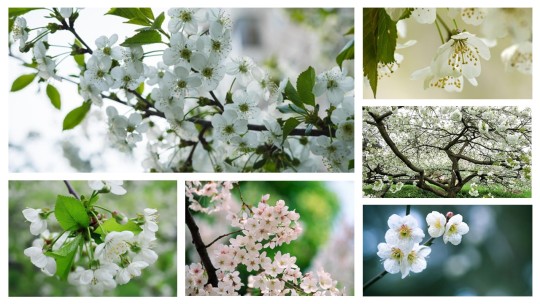
White cherry blossoms are the first flower featured in the final ending theme song credits. The cherry blossom (Prunus serrulata) is also known as the Japanese cherry and is the unofficial national flower of Japan. Its Japanese name Sakura (桜) has been derived from the word “saku” which means “to bloom”. Its meanings in hanakotoba are “beauty of spirit”, grace, chastity, excellent beauty, gentleness, good education and the “transience of life”. In Japan, cherry blossoms are also a symbol of the “beauty of impermanence”—a Shinto concept better known as “mono no aware” (物の哀れ) as their falling petals are a reminder that although life is short, it is beautiful and should be savoured. The Japanese concept of “natsukashi” (懐かしい) likewise emphasizes the fleeting nature of cherry blossoms. This concept refers to the happy-yet-wistful nostalgia for times and things that we will never be able to go back to. We will never get to experience those moments again, just like the ephemeral cherry blossoms, which makes them even more significant. Cherry blossoms bloom from March to April which is the start of the new fiscal year in Japan. As a result of this cherry blossoms have also come to symbolise new beginnings and springtime. Given that feudal Japanese soldiers associated cherry blossoms with honour, discipline, and dignity—falling flowers were thought to be symbolic of a Samurai's death. In Western floriography, cherry blossoms herald the changing of the seasons and symbolise renewal and rebirth. They also symbolise the fleeting nature of life, tenderness, forgiveness, strength, beauty, love, confidence, peace, friendship and gratitude. White cherry blossoms, in particular, represent purity, innocence, and simplicity, as well as hope and rebirth. White cherry blossom blossoms convey joy in the celebration of new beginnings. “Utsukushiki Zankoku na Sekai” (AOT ED1) depicts a young Mikasa rushing about looking for Eren in a dark, gloomy landscape before shifting into her older self. “Akuma no Ko” (AOT ED7) depicts a young Eren wandering around on his own in a dark cage until he breaks free into a colourful meadow before morphing into his older self. Meanwhile, the final ending, “Itterasshai”, depicts both a young Mikasa and Eren as well as an adult Mikasa and Eren uniting in a field of flowers beneath a picturesque sunset. Given that white cherry blossoms symbolise new beginnings, hope, and rebirth, their inclusion in this montage enhances its depiction of the pair reuniting in the afterlife—effectively tying the first and seventh ending sequences together. Various concepts embodied by the cherry blossom, particularly the transiency of life, mono no aware (the beauty of impermanence), and natsukashi (nostalgia for times and things we can't return to), are also significant themes in Attack on Titan's final arcs, making the flower's placement here appropriate.
-> Red Rose
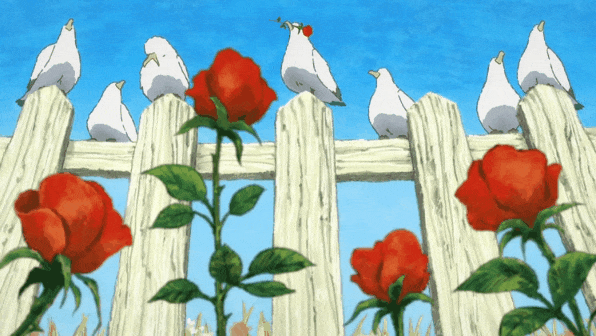
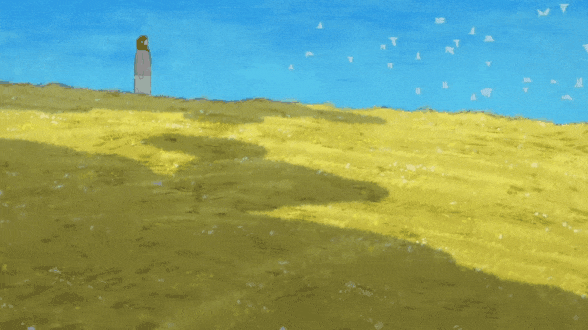

The next set of flower featured in the final ending sequence are red roses. In Japan, red roses are called benibara (紅薔薇). In hanakotoba roses symbolise love and beauty while red roses in particular symbolize affection and passionate love; while rose thorns represent “happiness in misfortune”. In Western floriography, roses symbolize love, passion, beauty, romance and secrecy. Red roses symbolize enduring passion, desire, affection and romance. In the visuals for “Itterasshai” four red roses are seen growing alongside a white picket fence. A white bird is later seen flying with a single red rose in its beak. Four red roses are said to symbolise that “nothing will ever come between us”. While a single red rose symbolises love at first sight. This suggests that nothing, not even death, is capable of impacting the pair's feelings for each other and that they have been in love since their first meeting as children. While red roses are an international symbol of romance, passion, devotion and long-lasting love, in some cultures they symbolise sacrifice, martyrdom, bravery, and strength. These qualities embody Eren’s character pretty well.
-> Dandelion


In the above panel, Mikasa holds two dandelion flowers in her hands. Dandelions (Taraxacum) are known as Tanpopo (たんぽぽ) in Japanese. Its meanings in hanakotoba are sincere love, separation and a prophecy of love. Additionally, in English floriography, dandelions represent faithfulness, hope, healing, light and happiness. They also symbolise joy, youthful thoughts, endurance, prosperity and healing. Given that the dandelion is a symbolic representation of faithfulness, happiness, healing, light, hope and prophecies of love—their use in this ending sequence further reinforces the concept of Mikasa reuniting with Eren in the afterlife.
-> White Daisy


Daisies (Bellis) are known as hinagiku (デイジー) in Japanese, and they hold the hanakotoba meanings of patience, purity, “secret love”, hope, innocence, beauty, peace, and faith. In English floriography, yellow daisies symbolise joy, and growth as well as a turning point or new beginning. Considering the daisy's symbolic connotations, its usage ending sequence once more accentuates the depiction of the pair finally getting a new start following the events of the series' conclusion. Its meanings of patience, hope, faith and secret love in particular highlight Mikasa going through the rest of her life hoping to be reunited after death.
───●◎●─── P.S. ───●◎●───
-> White Carnation
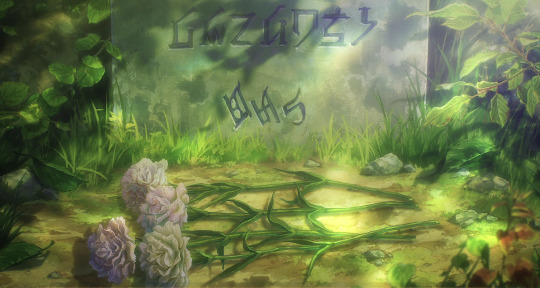
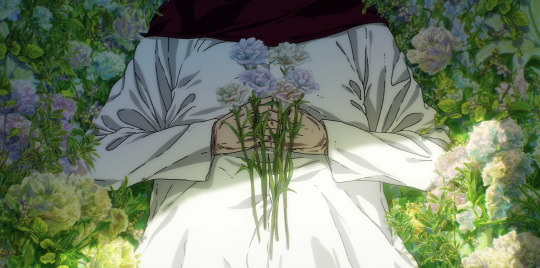

The flowers Mikasa places by Eren’s grave are the same flowers we see her holding after her passing. These flowers are known as carnations (Dianthus caryophyllus) and are called Kānēshon (カーネーション) in Japanese. Its meanings in hanakotoba are innocent and deep love. White carnations in particular hold the meaning “my love is love” and pure love in Japanese culture. In Western floriography, they symbolise love, fascination and distinction. Carnations are the most popular flower used at weddings in China, while in Korea they express admiration, love and gratitude. Carnations are frequently given as gifts in Japan to convey affection for loved ones or to honour those who have passed away. White carnations, in particular, represent purity and are therefore commonly utilised in ceremonies and rituals. The meaning of these flowers makes them an excellent choice for this scene and ties well into Mikasa and Eren’s dynamic. The flower’s meaning “my love is alive” perfectly encapsulates Mikasa’s feelings in the aftermath of the series and is a fitting offering for Eren’s gravestone.
○●○●○●○●○●○●○●○●○●○●○●○●○●○
╰┈➤ Attack on Titan ED7 Hanakotoba Analysis
╰┈➤ Anime Hanakotoba Posts Directory
[I wanted to contribute something towards the fandom considering that aot/snk has finally ended but I knew that doing a full-scale review of the episode would be a bad idea. In short, I want to say a lot of things but at the same time, there's nothing I want to say... When I saw the flowers featured in the final ed I knew I had to cover them. If you guys want me to do a Q&A for the show, I'd be willing to... So, feel free to send me questions to answer...
As a side note, I didn't go into a lot of detail here and stuck to focusing on eremika since I've already done a hanakotoba post for snk/aot--where I went into greater depth on the show's general themes.]

#snk#aot#attack on titan#shingeki no kyojin#anime#aot final season#eren yeager#eren jaeger#mikasa ackerman#eremika#eren x mikasa#eren yeager x mikasa ackerman#hanakotoba#snk hanakotoba#aot hanakotoba#anime hanakotoba#hanakotoba analysis#floriography#anime endings#anime ending theme#anime themes#anime music#snk final season#snk eren#snk mikasa#snk itterasshai
69 notes
·
View notes
Text
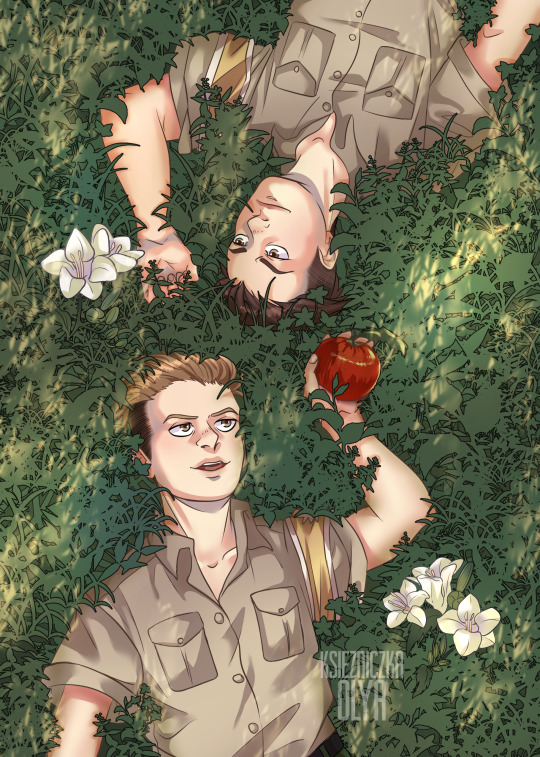
Another full artwork for the AOT zine, which hasn't been ever out
Flowers are freesia, which means "childhood" on hanakotoba
71 notes
·
View notes
Text
SNK ED 7: Akuma no Ko Hanakotoba Analysis
○●○●○●○●○●○●○●○●○●○●○●○●○●○
-> Evening Primrose

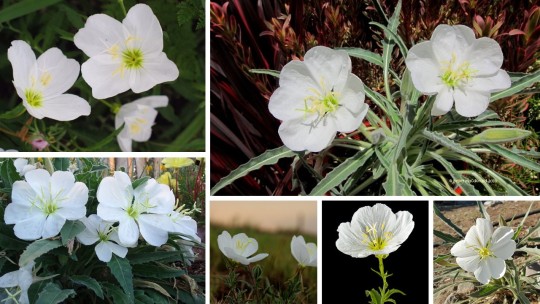
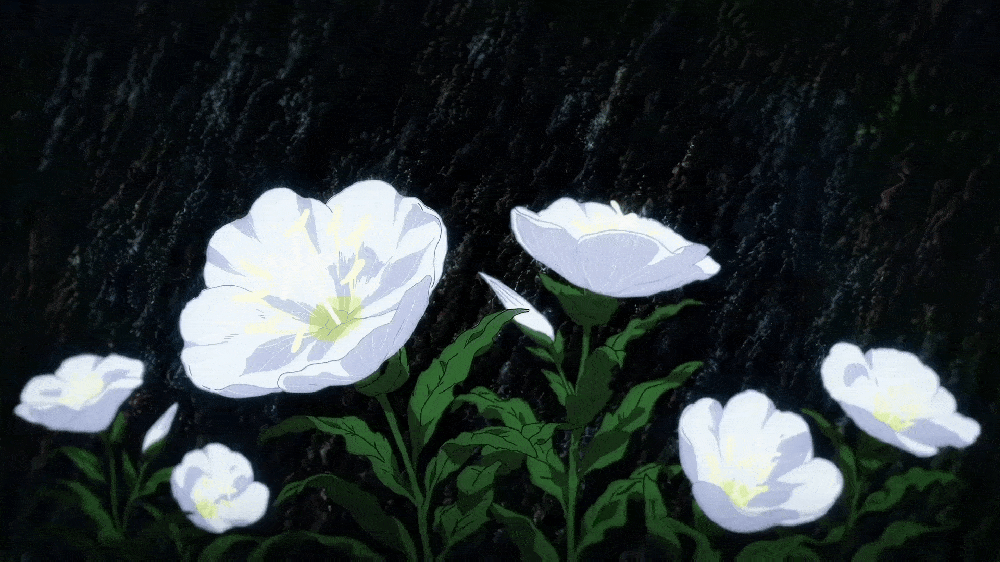
The first flower pictured in Akuma no Ko is the white evening primrose (Oenothera speciosa). Evening primrose is known as tsukimiso (月見草) in Japanese and its hanakotoba meanings are “silent affection” and “transient spirit”. In English floriography, they symbolize mute devotion, inconstancy, and faithfulness. As its name suggests, evening primrose blooms at night thus avoiding public view. This is where the meanings of silent affection and mute devotion are derived from. White evening primrose flowers turn pale pink when they wither in the morning, this is where the flower's meaning of inconstancy and transient spirit are derived from. In the visuals of this ending, young Eren is surrounded by countless white evening primrose flowers as our focus is drawn to a single evening primrose a single drop of blood stains the flower. This could symbolize Eren being corrupted by hatred, trauma, and loss or Eren’s love for those he is close to corrupting his morals. Eren’s shortened lifespan greatly contrasts his lofty goals and immense determination which ties into the flower symbolising transient spirit. Eren has stated that he will keep “moving forward” and has greatly changed since his first appearance both physically as well as mentally. This fits in well with the flower symbolizing inconstancy. Eren has hidden his feelings and intentions from his friends and loved ones, especially Mikasa, until the moment of his death. This ties in well with the flower symbolizing mute devotion, faithfulness, and silent affection.
-> Wildflowers (Part 1)
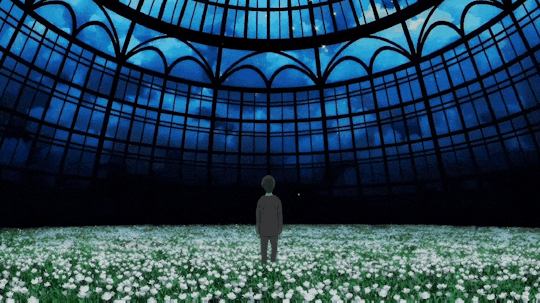
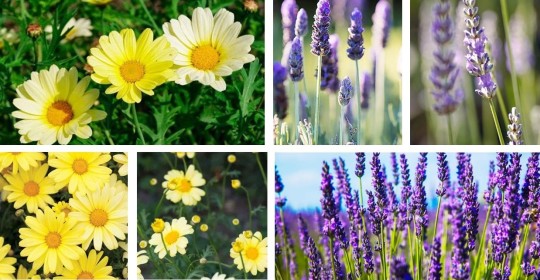
As the song reaches its chorus both the cage surrounding Eren as well as the accompanying darkness disappear as he is surrounded by a bright field of blooming wildflowers. The most notable of these wildflowers are yellow daisies and lavender. Daisies (Bellis) are known as hinagiku (デイジー) in Japanese, and they hold the hanakotoba meanings of faith, “secret love”, hope, beauty, peace, and faith. In English floriography, yellow daisies symbolise joy, and growth as well as a turning point or new beginning. Season 4 has been an immense defining moment for Eren, and his final actions have resulted in a tentative peace sort of new beginning for humanity tying into the flower symbolising turning points, new beginnings and peace. Lavender (Lavandula) is known as rabenda (ラベンダー) in Japanese. Its hanakotoba meanings include “expectation”, “suspicion”, “distrust” and “answer me”. In English floriography, lavender flowers symbolise devotion and love in addition to distrust and silence. The tranquillizing effect of lavender and its mysteriously strong scent is what its meanings of silence and distrust have given rise to its respective meanings of “silence” and “distrust”. Throughout most of the final arc, Eren’s motivations and feelings have been secret to his friends and comrades. In the days leading up to his defection from the scouting regiment, others regarded him with suspicion and distrust whilst simultaneously having expectations for him. After his defection, his friends demanded answers from him to no avail. This ties into lavender’s meanings of expectation, distrust, suspicion, silence and “answer me”. Lavender’s meaning of devotion complements Eren’s determination towards protecting his loved ones is shown through his willingness to dirty his hands, go through immense suffering and even temporarily hurt them for their own ultimate benefit.
-> Wisteria
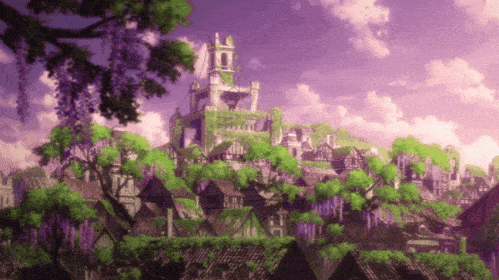
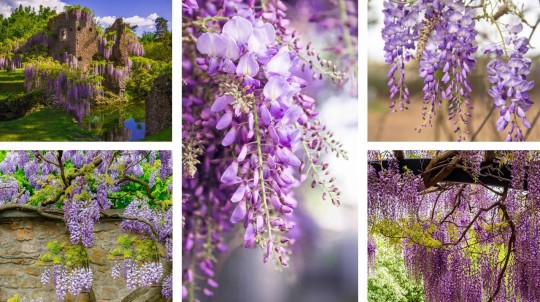
We are then shown various locales in Paradise Island including Trost district and Utgard castle all of which are pictured as decrepit, uninhibited ruins overtaken by various plants. The most prominent of these is the wisteria pictured growing on the brick walls of the Trost district. Wisteria is known as fuji (藤) in Japanese. Its hanakotoba meanings are “kindness”, “welcome”, “never leave” and “intoxicated/drunk in love”. In Japanese culture, wisteria has also come to symbolize honour, wisdom, endurance, steadfastness and support. In English floriography, wisteria is associated with being steadfast, faithful and welcoming. Additional meanings include tenderness and sensitivity. Wisteria’s meanings of steadfastness and endurance complement Eren’s determination and stubbornness while its meanings of honour and kindness contradict Eren’s willingness to sacrifice the greater good in order to protect those important to him. Wisteria’s tendency to grip tightly to trees to grow up straight is what has led to it coming to mean an unwillingness to let go or being drunk in love. This concept strongly encapsulates Eren’s feelings towards Mikasa, particularly highlighting his unwillingness to see her move on after his death.
-> Wildflowers (Part 2)

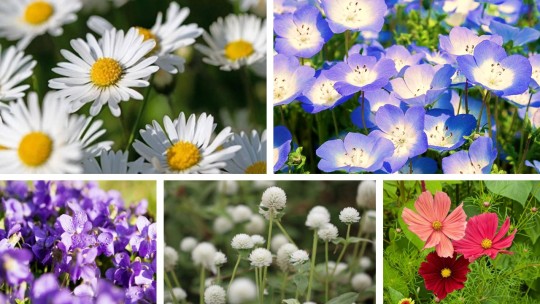

The final panels in this ending show older Eren walking freely in the field of wildflowers. As our focus is shifted to his feet trotting through the myriads of flora. The most notable of which are white daisies, violets, white globe amaranth, nemophila and cosmos. Daisies (Bellis) are known as hinagiku (デイジー) in Japanese, and they hold the hanakotoba meanings of faith, “secret love”, hope, beauty, peace, and faith. In English floriography, white daisies symbolise innocence. The concept of childhood innocence being corrupted by cruelties of war and discord is a central theme in Attack on Titan. Violets (Viola) are known as sumire (菫) in Japanese. Its hanakotoba meanings include “humility”, “sincerity”, “small happiness” and “love”. While in English floriography they represent faithfulness, modesty, affection and virtue. The meaning “small happiness” resonates with Eren’s ideology as he is willing to sacrifice many so that those he cares for (a small minority) are happy. Nemophila are more commonly known as baby blue eyes and are called rurikarakusa (ネモフィラ) in Japan. Its hanakotoba meanings are daintiness, “I forgive you” and “success everywhere”. Although Eren maintains a determined and cold persona in order to fulfil his plans, deep down he is scared and unsure which ties into the flower symbolising daintiness. In the end despite dying and being stopped partway, his loved ones are able to live fulfilling lives tying into the flower’s meaning of “success everywhere”. White globe amaranth (Gomphrena globosa) is known as sennichikou (センニチコウ) in Japanese. Its hanakotoba meanings are unfading love as well as timeless/eternal love. In English floriography, they symbolise unfading love, immortality, hope in misery as well as what is unchangeable. The name and meaning of this flower both derive from the flower’s long flowering period. The phrase “hope in misery” perfectly encapsulates what many of the characters including Eren have been struggling to grasp. The meanings of unfading, timeless and eternal love describe many of the friendships and relationships in the show and encapsulate its themes of love and loss. At this point, Eren is set on fulfilling his goals despite his friends wanting to change his mind. This ties into the flower symbolising what is unchangeable. The Cosmos flower is known as kosumosu (宇宙) in Japan. Its name is derived from the Greek word "Kosmos" meaning harmony and order. This has contributed to the flower coming to symbolise harmony, beauty and peace in English floriography. Its hanakotoba meanings include humility, purity, affection and modesty. The Cosmos flower is also said to represent "the joys that love and life can bring". Ironically Attack on Titan rarely focuses on the joys that love and life can bring but instead highlights that while beautiful, the world is also especially cruel. Additionally, the cosmos flower���s meanings of peace, purity and harmony are juxtaposed with the dark themes of war, loss, corruption and sacrifice in the show.
P.S.
-> Bellflower

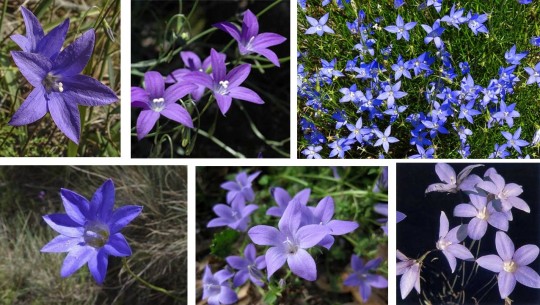

Bellflowers have made consistent appearances in Attack on Titan since the first episode. Bellflowers are from the Campanulaceae family and are known as berufurawā (ベルフラワー) or kikyo (キキョウ) in Japanese. Its hanakotoba meanings are gratitude and sincerity. While in English floriography they symbolise constancy, sorrowful regret, humility and kindness. The flowers made notable appearances in the opening scene under the tree where Eren and Mikasa were sitting as well as in season 2 where Eren unlocked the co-ordinate power of the founding titan after Mikasa’s speech. In both scenes, we see characters being vulnerable after having premonitions of future loss and having faced repeated loss. This ties in with the flower’s meanings of humility, sorrowful regret, and sincerity. After Mikasa’s speech—wherein she thanked Eren for everything he had done for her—Eren gets up and is motivated to persevere once more. This ties in with the flower’s meanings of constancy, kindness, and gratitude.
○●○●○●○●○●○●○●○●○●○●○●○●○●○
[If you liked this post, check out my other hanakotoba analysis posts here ❀]
[I didn't go into a lot of detail here because everything is very abstract and subtle and is thus difficult to explain than with other shows... Also, many people—including myself—have very conflicting views on and interpretations of the ending of Attack on Titan... So, I don't want to stir up discourse.]
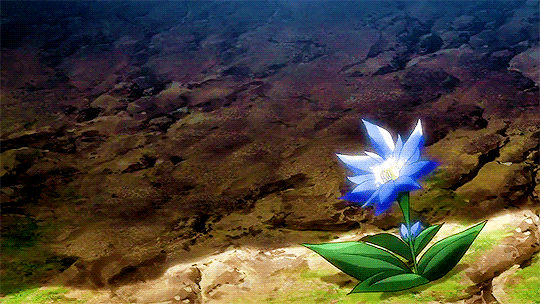
#I have 4 more hanakotoba posts about 4 other anime coming soon so stay tuned!#shingeki no kyoujin#shingeki no kyojin#snk#aot#attack on titan#attack on titan final season#aot s4#snk s4#attack on titan season 4#snk season 4 part 2#aot season 4#aot season 4 part 2#snk season 4#hanakotoba#hanakotoba analysis#anime#anime endings#anime ending theme#anime songs#anime hanakotoba#floriography#eren jaeger#eren yeager#snk eren#aot eren#eremika#eren x mikasa#akuma no ko#snk ed7
55 notes
·
View notes
Text
◤─•~❉᯽❉~•─◥ Anime Hanakotoba Posts Directory

╰┈➤ 1.0 Gintama OP15
╰┈➤ 2.1 Fruits Basket ED4 P1
╰┈➤2.2 Fruits Basket ED4 P2
╰┈➤3.0 Boku no Hero Academia ED10
╰┈➤4.0 Chihayafuru ED3
╰┈➤5.1 Shiguang Dailiren/Link Click Official Art
╰┈➤5.2 Shiguang Dailiren/Link Click Official Art - Lu Guang Omake
╰┈➤5.3 Shiguang Dailiren/Link Click Season 2 Key Visual
╰┈➤6.0 Shingeki no Kyojin/Attack on Titan ED7
╰┈➤7.1 Bleach P1: OP16 & ED31 ~ Ichigo Kurosaki
╰┈➤7.2 Bleach P2: ED31
╰┈➤7.3 Bleach P3: OP16 & ED31 ~ Gotei 13
╰┈➤8.1 Tiān Guān Cì Fú/Heaven Official's Blessing P1
╰┈➤8.2 Tiān Guān Cì Fú/Heaven Official's Blessing P2
╰┈➤9.0 Jujutsu Kaisen
╰┈➤10.0 Shingeki no Kyojin/Attack on Titan Final ED - Itterasshai
╰┈➤11.1 Mo Dao Zu Shi/Grandmaster of Demonic Cultivation P1
╰┈➤11.2 Mo Dao Zu Shi/Grandmaster of Demonic Cultivation P2
╰┈➤12.1 Kusuriya no Hitorigoto P1 A: OP1 Hana Ni Natte
╰┈➤12.2 Kusuriya no Hitorigoto P1 B: OP1 Hana Ni Natte
╰┈➤12.3 Kusuriya no Hitorigoto P2: OP2 Ambivalent
╰┈➤13.0 Sousou no Frieren
◣─•~❉᯽❉~•─◢
P.S: If you liked any of these posts and there's a particular anime scene, anime opening or anime ending—with some flower symbolism in it—that you want me to make a post about, send me an ask and I'll gladly do it if I've seen the show...

#anime#hanakotoba#anime hanakotoba#flower symbolism#floriography#gintama#gintama op15#fruits basket#fruits basket 2019#boku no hero academia#bnha#mha#my hero academia#bnha season 6#mha season 6#mha ed10#chihayafuru#chihayafuru anime#shiguang dailiren#link click#snk#aot#attack on titan#shingeki no kyojin#bleach#tgcf#heaven official's blessing#jjk#jujutsu kaisen#the apothecary diaries
36 notes
·
View notes